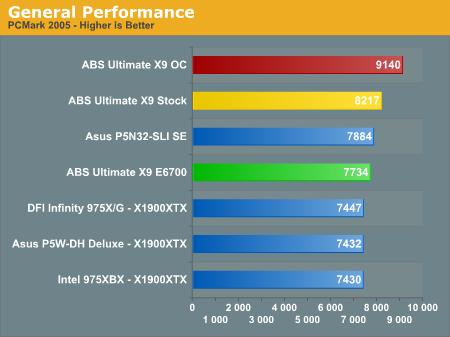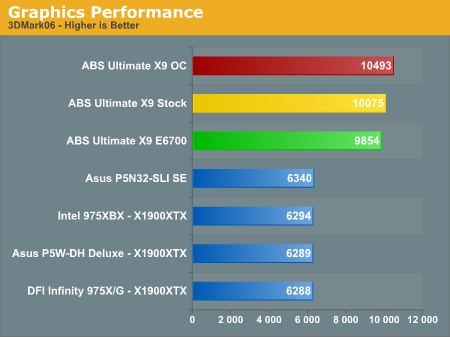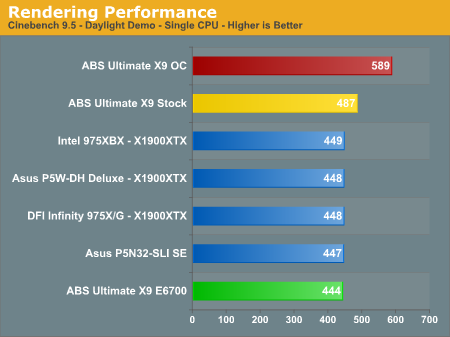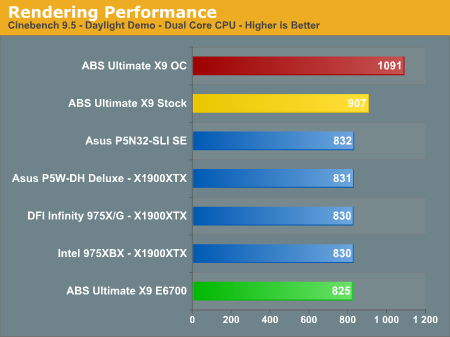ABS Ultimate X9: Core 2 Extreme Hits a Speed Bump
by Jarred Walton on August 18, 2006 1:35 PM EST- Posted in
- Systems
Standard Application Benchmarks
We'll begin with a look at typical application performance. Results from PCMark05, 3DMark06, and Cinebench 9.5 were collected. As mentioned already, the higher clock speed of the ABS system should result in higher performance, particularly in situations where we are CPU limited. Those of you wondering how a 3.5 GHz Core 2 processor performs need look no further.




The results in 3DMark06 aren't particularly meaningful, as none of the other systems were tested with a CrossFire setup. Given that we consider 3DMark to be a synthetic GPU performance test, we're not too concerned with the numbers anyway. One thing that you can see with 3DMark06 is that we are almost completely GPU limited, gaining only 6% more performance with a 32 %CPU clock speed increase. We will see if that same pattern holds true for actual games on the coming pages.
Performance results in PCMark05 are also slightly skewed by the CrossFire graphics configuration, not to mention the use of two Raptor drives in RAID 0. However, we feel these results are more real world, and the simple fact of the matter is that faster hard drives, GPUs, and processors can certainly improve the overall system performance to the point where it is noticeable by the end user. Increases in CPU speed come with a roughly 2-to-1 improvement in PCMark05 scores. The 20% OC is 11% faster than the stock X6800, and the X6800 is 6% faster than the E6700 while being clocked 10% higher.
Closing up with Cinebench 9.5, we have an application that scales almost linearly with CPU clock speed. If your typical usage scenario consists of a lot of video encoding or 3D rendering, faster processors are extremely helpful, and that's what we see here. Cinebench also shows the advantage of multicore systems, improving rendering performance by over 85% when moving from a single core to dual cores. Unfortunately, not all commonly used tasks benefit that much from multiple processor cores, but heavy multitasking will certainly be faster.
We already knew that the Core 2 Extreme was fast, and overclocking it just makes it that much faster. Many commonly used tasks will benefit, particularly CPU-intensive tasks. Games are often considered CPU-intensive in nature, of course, so let's see what happens when we put the X1900 cards to good use.
We'll begin with a look at typical application performance. Results from PCMark05, 3DMark06, and Cinebench 9.5 were collected. As mentioned already, the higher clock speed of the ABS system should result in higher performance, particularly in situations where we are CPU limited. Those of you wondering how a 3.5 GHz Core 2 processor performs need look no further.




Performance results in PCMark05 are also slightly skewed by the CrossFire graphics configuration, not to mention the use of two Raptor drives in RAID 0. However, we feel these results are more real world, and the simple fact of the matter is that faster hard drives, GPUs, and processors can certainly improve the overall system performance to the point where it is noticeable by the end user. Increases in CPU speed come with a roughly 2-to-1 improvement in PCMark05 scores. The 20% OC is 11% faster than the stock X6800, and the X6800 is 6% faster than the E6700 while being clocked 10% higher.
Closing up with Cinebench 9.5, we have an application that scales almost linearly with CPU clock speed. If your typical usage scenario consists of a lot of video encoding or 3D rendering, faster processors are extremely helpful, and that's what we see here. Cinebench also shows the advantage of multicore systems, improving rendering performance by over 85% when moving from a single core to dual cores. Unfortunately, not all commonly used tasks benefit that much from multiple processor cores, but heavy multitasking will certainly be faster.
We already knew that the Core 2 Extreme was fast, and overclocking it just makes it that much faster. Many commonly used tasks will benefit, particularly CPU-intensive tasks. Games are often considered CPU-intensive in nature, of course, so let's see what happens when we put the X1900 cards to good use.










48 Comments
View All Comments
JarredWalton - Saturday, August 19, 2006 - link
Don't use the (bracket) H (closebracket) abbreviation in our comments - that's the code for highlight enable, which makes your text white. LOL
JarredWalton - Saturday, August 19, 2006 - link
Multiple uses cause even more troble. :p
JarredWalton - Saturday, August 19, 2006 - link
Have I shut off all text highlights yet? Enquiring minds want to know!
JarredWalton - Friday, August 18, 2006 - link
Take a look at similarly configured Alienware, Falcon NW, VoodooPC, etc. systems and see what they cost. $4500 for the ABS is an absolute bargain by comparison. And don't think that all of those systems are going to be more stable than this ABS. I tried a Quad SLI config for a while that was much, MUCH less stable than this system. The review would have been very unfavorable, but as the company basically pulled the configuration I had there was no reason to "review" a phantom product.Alienware is about $4300 without overclocking or watercooling.
FNW Talon with E6700 and 7950GX2: $6000
FNW Mach V with X6800 watercooling and CrossFire: $8230
VoodooPC Omen CrossFire: $7600
None of those come factory overclocked as far as I can tell, but I'm sure they could be. Still, there's a big difference between $4500 and $6000+. Are they more stable? I don't know - I haven't tested any of the above configurations.
As for ways to improve system reviews, I'm open for suggestions. Simply stating "be like HardOCP" doesn't really help much. What would you like to see added? Compare what this review told you about gaming to what others show, and let me know what's really different about the conclusions. Where do we fall short? I have plenty more system reviews, so if there are specific improvements to be made I'd love to try and make them.
Thanks,
Jarred Walton
Editor
AnandTech.com
yyrkoon - Friday, August 18, 2006 - link
Personally, I find your articles fine the way they are, whihc is why I'll read YOUR articles over Toms any day of the week (because you guys seem to tell it how it is, and how you'd think the company you're reviewing would want to hear it.yyrkoon - Friday, August 18, 2006 - link
err and NOT how you'd think the company you're reviewing would want to hear it (left out 'not'), sorry.MarkHark - Friday, August 18, 2006 - link
Thumbs up for you, Jarred, twice in fact!First for a well-thought, well-written review, second and most important for your last comment.
samuraiBX - Friday, August 18, 2006 - link
now if one of you will please run over me so I can get the money from my insurance... :PJarredWalton - Friday, August 18, 2006 - link
We've got a $1400 system review coming soon, for "the rest" of our readers. :)yyrkoon - Friday, August 18, 2006 - link
Sub 1,000 system review would be much bettter ;) Anyhow, nice clean looking wiring (until you look into the drive bays), additional fan on a water cooled CPU ?! 3000-4000 Price ?!Personally, I would never consider buying a OEM type system, but man even though it has semi clean wiring, neat gadgets like a Air cooling assisted water block, excellent non gaming performance, I would expect said system to be stable, offer the best gaming performance period, and to cook for me . . .